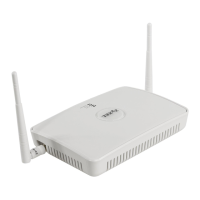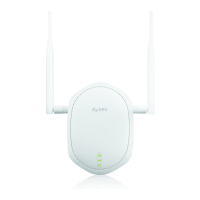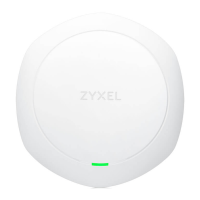
Do you have a question about the ZyXEL Communications NWA3560-N and is the answer not in the manual?
| Wireless Standard | 802.11a/b/g/n |
|---|---|
| Frequency Bands | 2.4 GHz, 5 GHz |
| Maximum Data Rate | 300 Mbps |
| MIMO Technology | 2x2 MIMO |
| Ethernet Ports | 1 x 10/100/1000 Mbps |
| Antenna Type | Internal |
| Power over Ethernet (PoE) | 802.3af |
| Antenna Gain | 3 dBi |
| Security | WEP, WPA, WPA2 |
| Operating Modes | Access Point, Repeater |
| Management | Web-based, SNMP |
| Operating Temperature | 0°C to 50°C |
Describes the target audience for this manual, requiring basic knowledge of TCP/IP networking.
Lists other documents like Quick Start Guide and Support Disc for additional information.
Explains how warnings and notes are presented in the guide, highlighting potential device harm.
Defines conventions used for product references, keystrokes, and screen navigation.
Introduces the NWA3000-N Series AP, highlighting its features and suitability for mission-critical networks.
Details the operating modes of the device, including AP + Bridge and MBSSID.
Explains the CAPWAP protocol and how one AP can manage up to 24 others.
Explains that the Web Configurator allows easy device setup and management via an internet browser.
Provides steps to access the Web Configurator, including the default IP address and login details.
Details the main screen layout, divided into Title Bar, Navigation Panel, and Main Window.
Explains how the device stores and uses settings as objects for easier configuration and reuse.
Provides information on configuring main features, listed sequentially as in the Web Configurator menus.
Introduces various objects like User, AP Profile, and MON Profile used for configuration.
Demonstrates setting up a wireless network using CAPWAP for staff and guest connections.
Explains how to use the Dashboard screens to check status information about the device.
Describes the main Dashboard screen, displaying general device information and status in widgets.
Explains how to use Monitor screens to check status and statistics information.
Provides general LAN interface information and packet statistics.
Displays which APs are currently connected to the device, available in controller mode.
Shows statistics for the device's wireless radio transmitters.
Discusses using the device in management mode for standalone or CAPWAP network configurations.
Explains CAPWAP protocol implementation, dataflow protection, and network examples.
Describes the screen used to configure the device as a controller, standalone AP, or managed AP.
Explains how to configure the device's LAN Ethernet interface and VLAN settings.
Lists Ethernet interfaces and provides descriptions for configuring IP address assignment and VLANs.
Explains how to use Wireless screens to configure the device's management of Access Points.
Sets how the device allows new APs to connect to the network, available in controller mode.
Manages all connected APs, including general wireless settings for standalone or managed APs.
Assigns APs to rogue or friendly lists, used for monitoring wireless devices in the vicinity.
Configures wireless network traffic load balancing between APs and the device.
Explains Device HA, allowing a backup device to take over if the master device fails in controller mode.
Enables/disables Device HA and shows monitored interfaces status.
Configures active-passive mode device HA settings, monitored interfaces, and backup device synchronization.
Describes setting up user accounts and controlling access to device configuration and services.
Provides a summary of all user accounts, including types and descriptions.
Controls default settings, login, lockout, and other user settings for the device.
Explains how to configure preset profiles for Access Points (APs) connected to the wireless network.
Allows creation of radio profiles defining settings for APs' radio transmitters.
Configures SSID profiles, including name, security, QoS, and VLAN ID for wireless networks.
Manages wireless security configurations for SSIDs, including encryption methods.
Provides an additional security layer by allowing or blocking access based on wireless client MAC addresses.
Explains setting up monitor mode configurations for APs to scan for nearby wireless devices.
Allows creation of monitor mode configurations for APs to scan for wireless devices.
Explains how the device uses certificates for authenticating users based on public-private key pairs.
Provides a summary list of certificates and certification requests, allowing generation and export.
Saves CA and remote host certificates, allowing the device to trust imported valid certificates.
Explains how to configure general device settings like Host Name, Date/Time, and Console Speed.
Configures a unique name for the device on the network, which is propagated via DHCP.
Sets the device's system time manually or gets it from an external time server.
Configures SSH (Secure Shell) for securely accessing the device's command line interface.
Explains how to configure daily reporting and log settings.
Controls detailed settings for each log, including email profiles and remote syslog servers.
Explains configuration files and shell scripts for device settings and command execution.
Stores, names, downloads, and uploads configuration files for device settings.
Checks current firmware version and uploads new firmware to the device.
Stores, names, downloads, uploads, and runs shell script files for device commands.
Describes using diagnostic screens for troubleshooting device issues.
Captures data packets going through the device's interfaces for network problem analysis.
Captures wireless network traffic going through AP interfaces for troubleshooting.
Explains the process of restarting the device and saving configuration changes.
Allows remote users to restart the device via the Web Configurator or CLI command.
Describes the process of shutting down the device safely to prevent firmware corruption.
Provides steps to shut down the device via the Web Configurator or CLI command.
Offers suggestions to solve common problems categorized by issue type.
Troubleshoots issues related to the device not powering on or LEDs behaving unexpectedly.
Provides solutions for forgetting the IP address or being unable to access the Login screen.
Addresses issues with accessing the internet, including no access or slow/intermittent connections.
Helps resolve problems with wireless clients connecting to the AP or accessing the network.
Provides steps and guidance for securely mounting the device on a wall.
Provides descriptions of example log messages related to internal system errors.
Guides on importing public key certificates into web browsers for secure site verification.
Discusses ad-hoc and infrastructure wireless LAN topologies.
Defines a Basic Service Set (BSS) where clients communicate through one access point.
Explains an Extended Service Set (ESS) as overlapping BSSs connected by a wired network.
Describes radio frequencies used by wireless devices and the importance of channel selection.
Explains RTS/CTS handshake to prevent collisions due to hidden nodes in wireless networks.
Covers wireless security methods like data encryption and client authentication.
States the copyright information for the publication.
Disclaims liability for product application or use, and patent rights.
Includes FCC and CE compliance information for the device.












